The Latest from Boing Boing |  |
- Velvet Underground vs. Marvin Gaye and Tammi Terrell
- What's up on the Internet: Yaka-wow!
- Volcano science update: Two surprising reasons to go boom
- Richard Dawkins and Christopher Hitchens are planning to have the Pope arrested in the UK
- Mother explains why she gives pot to her 9-year-old autistic son
- Chimerical Avatars and Other Identity Experiments from Prof. Fox Harrell
- PlayPen: an open-ended adventure game made of Wiki
- SIDTube: Watch Sleep Is Death stories, play online
- Just look at this bad-ass volcano
- Cookbook typo: "salt and freshly ground black people"
- Venus flytraps in the wild, and in danger
- Creepy disembodied robot mouth
- Compilation of people on YouTube "Hey, Guys"
- Crayon rockets
- The Alot, an imaginary mammal
- Amazon's plans to kill book publishers thwarted by Apple
- Daniel Rubin's celebrity caricatures
- Cocaine smuggler's bestiality farm
- Sly Stone at Coachella defies understanding
- Lib Dems soar in UK polls after debate
- Adam Savage's speech to the Harvard humanists
- iPhone 4G details emerge
- The Asian Art Museum does Shanghai: opium hulks, Communist propaganda, and neon brush strokes
- GoogleSharing: blending your net-activity with others to trick Google
- TOR for Android: anonymize your phone's data-connection
- George Washington owes $100K in library fines
| Velvet Underground vs. Marvin Gaye and Tammi Terrell Posted: 19 Apr 2010 09:00 PM PDT My pal Tara over at Dangerous Minds found this mashup of Velvet Underground's "Venus in Furs" and Marvin Gaye and Tammi Terrell doing "Ain't No Mountain High Enough." As someone who considers VU one of the greatest bands of all time, and also has a lifelong love of old soul, I was expecting the worst but hoped for the strange. On that, I think it delivers. |
| What's up on the Internet: Yaka-wow! Posted: 19 Apr 2010 05:16 PM PDT  Are you a breezy person who goes, "Yaka-wow!"? Maybe you already were, and just didn't know it. Alice Bell, science communication lecturer at Imperial College, London, explains:
More specifically, yaka-wow is the accidental brainchild of British neuroscientist Susan Greenfield. In the UK, Greenfield is known for holding the rather controversial position that use of computers and video games irreparably damages children's brains—unless, of course, said children are using her computer games, in which case they will become smarter. You see the problem. Last Thursday, Greenfield gave an interview to the London Times, which led to this fabulous exchange:
Within hours, yaka-wow had inspired a Twitter stream, poster, T-shirt and burgeoning personal philosophy. But why yaka-wow? Bell says it's probably a fortuitous typo:
Naturally, that quote inspired mathematician Matt Parker to thoroughly wow the web by pulling both his socks on at the same time. Image courtesy the brilliant mind of Adam Rutherford. |
| Volcano science update: Two surprising reasons to go boom Posted: 19 Apr 2010 05:44 PM PDT  Geologic wonder and part-time smoke bomb, Eyjafjallajokull, was still burping out ash clouds today, though experts say the eruption is showing signs of slowing down. Our thoughts are with all the stranded travelers and the tongue-tied TV journalists forced to go on trying to pronounce the volcano's name. On the plus side, the Eyjafjallajokull eruption has become a bright and shiny news hook for all sorts of interesting volcano science stories.
First fun fact:One volcanic eruption can trigger a blast in a nearby volcano Volcanoes explode because the pressure of the magma building up in the chamber forces it out, which then relieves the stress in the chamber; but what relieves stress in the one chamber could increase stress in a neighboring chamber. Next up: Some recent research suggests that climate change could trigger more frequent eruptions in Iceland |
| Richard Dawkins and Christopher Hitchens are planning to have the Pope arrested in the UK Posted: 19 Apr 2010 03:37 PM PDT It's a buddy-cop movie plot for the new millennium: Richard Dawkins and Christopher Hitchens are teaming up to arrest the Pope when he comes to Britain in September. Dawkins, author of The God Delusion, said: "This is a man whose first instinct when his priests are caught with their pants down is to cover up the scandal and damn the young victims to silence."Richard Dawkins calls for arrest of Pope Benedict XVI |
| Mother explains why she gives pot to her 9-year-old autistic son Posted: 19 Apr 2010 03:30 PM PDT Marie Myung-Ok Lee wrote a great piece for Slate about giving cannabis to her 9-year-old autistic son. Why I Give My 9-Year-Old Pot |
| Chimerical Avatars and Other Identity Experiments from Prof. Fox Harrell Posted: 19 Apr 2010 04:44 PM PDT  After spending his youth happily playing computer and table-top role-playing games as pale-grey-skinned elves with long, straight, silver hair (usually over one eye), or "forcing African-coifed robot pilots into the anime world of Macross," Fox Harrel says he started wanting to play characters that expressed and presented themselves in ways that captured his real world cultural values, though still set in those same fantasy worlds. That hasn't always come easily. I asked Fox, a computer scientist and literary artist, for some examples.
Fox is a professor and director of the Imagination, Computation, and Expression Lab/Studio at Georgia Tech. His research and software development are all about creating new opportunities for fluid, nuanced narratives, identities, and social categories to take shape--and shift shape--online.
Shape-shifting poetics
Fox: If I were to enter that "Lissa is courageous like a lion" and someone else enter that "Lissa is strong like a stegosaurus," the system would output a hybrid animal images as an avatar. The idea is to look at how people define each other socially, like the collective ratings of sellers on eBay, but through richer imagery and with more nuance. It is also about the difference between one's self-conception and how others might see her, an idea written about as long ago as W.E.B. DuBois's introduction of the term "Double Consciousness" in The Souls of Black Folk. Conjuring social change through computation
|
| PlayPen: an open-ended adventure game made of Wiki Posted: 19 Apr 2010 01:55 PM PDT 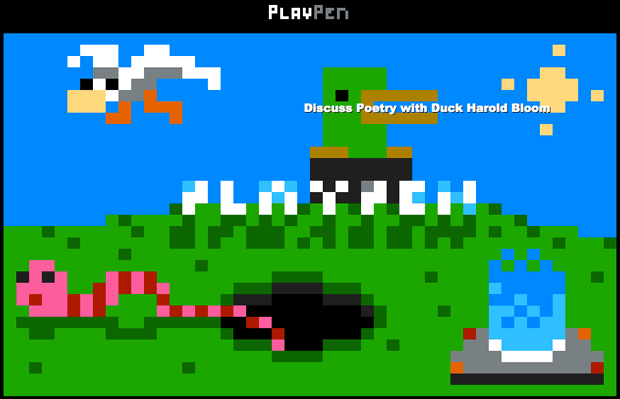 In other free-form gaming developments, Farbs -- the mind behind local favorite 'Game To Get', Captain Forever -- has officially unveiled PlayPen, a community site that harnesses the scale and ease-of-use of wikis and morphs it into an open-ended lo-fi adventure game. Which makes it sound a bit more complicated than it actually is: in essence, PlayPen is a low-res pixel-art editor that allows anyone to branch or modify individual screens, hyperlinking them in as many varied directions as you or anyone could imagine. Is it chaos? It absolutely, beautifully is: even in the few short days that the public release has been open, it's already seen some 1500 new pages added, with paths laid down to meet pathetic gnome-centaurs while on mushroom-addled freakouts, or, uh, unmediated poetry discussions with Duck Harold Bloom, which is about all you could ask for -- and is yours for the modifying if it doesn't live up to your darkest desires. PlayPen [Farbs] In other free-form gaming developments, Farbs -- the mind behind local favorite 'Game To Get', Captain Forever -- has officially unveiled PlayPen, a community site that harnesses the scale and ease-of-use of wikis and morphs it into an open-ended lo-fi adventure game. Which makes it sound a bit more complicated than it actually is: in essence, PlayPen is a low-res pixel-art editor that allows anyone to branch or modify individual screens, hyperlinking them in as many varied directions as you or anyone could imagine. Is it chaos? It absolutely, beautifully is: even in the few short days that the public release has been open, it's already seen some 1500 new pages added, with paths laid down to meet pathetic gnome-centaurs while on mushroom-addled freakouts, or, uh, unmediated poetry discussions with Duck Harold Bloom, which is about all you could ask for -- and is yours for the modifying if it doesn't live up to your darkest desires. PlayPen [Farbs] |
| SIDTube: Watch Sleep Is Death stories, play online Posted: 19 Apr 2010 01:20 PM PDT 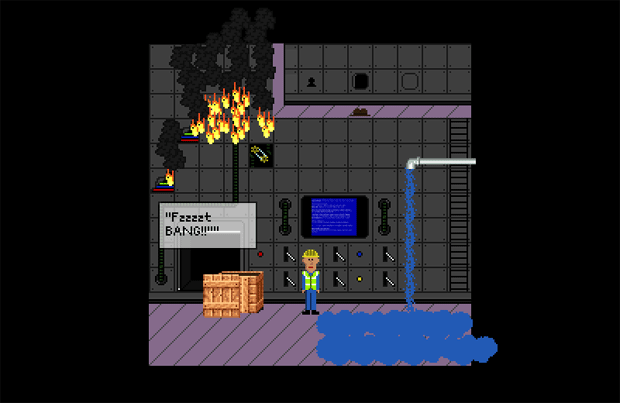 Even though Jason Rohrer's mediated-multiplayer storytelling engine Sleep is Death -- first featured here on Boing Boing -- has only been in the hands of early buyers for just over a week (with a wider official release date due tomorrow), third parties have already jumped into the fray to support its fast-growing community of players. Chief among these is SIDTube, a low-res but highly-functional site featuring both matchmaking capabilities to host and play online with friends and strangers alike, and a gallery of completed stories that can be flipped through and rated. Above: The Machine, a Modern Times-ish slapstick story by one 'FranticPea', with plenty more available for your perusal. For more info on Sleep is Death and to get the game yourself, check Rohrer's official site. Even though Jason Rohrer's mediated-multiplayer storytelling engine Sleep is Death -- first featured here on Boing Boing -- has only been in the hands of early buyers for just over a week (with a wider official release date due tomorrow), third parties have already jumped into the fray to support its fast-growing community of players. Chief among these is SIDTube, a low-res but highly-functional site featuring both matchmaking capabilities to host and play online with friends and strangers alike, and a gallery of completed stories that can be flipped through and rated. Above: The Machine, a Modern Times-ish slapstick story by one 'FranticPea', with plenty more available for your perusal. For more info on Sleep is Death and to get the game yourself, check Rohrer's official site. |
| Just look at this bad-ass volcano Posted: 19 Apr 2010 12:46 PM PDT |
| Cookbook typo: "salt and freshly ground black people" Posted: 19 Apr 2010 12:09 PM PDT Penguin Group Australia accidentally published copies of the Pasta Bible containing an unfortunate spell check error. A recipe calling for "salt and freshly ground black pepper" actually read "salt and freshly ground black people." The company is destroying and reprinting 7,000 copies of the book, but not recalling ones that have already hit bookstores. According to the company's head of publishing, Bob Sessions, it was an honest mistake. From The Age: "We're mortified that this has become an issue of any kind and why anyone would be offended, we don't know," he said..."Hot water over spell check" Previously: |
| Venus flytraps in the wild, and in danger Posted: 19 Apr 2010 11:56 AM PDT The most famous of carnivorous plants, the Venus flytrap, is surprisingly rare in the wild. The plant is only found on the 100-mile-long wet pine savannas on the edge of South and North Carolina. And apparently, there are only 150,000 of them out there. And according to James Luken, a botanist at Coastal Carolina University, that population is in danger from development and poaching, among other threats. From Smithsonian (Wikimedia Commons image): "The Venus Flytrap's Lethal Allure" Previously: |
| Creepy disembodied robot mouth Posted: 19 Apr 2010 11:08 AM PDT Robotic mouth recites vowels, but doesn't seem too happy about it. (Via Robert Popper) |
| Compilation of people on YouTube "Hey, Guys" Posted: 19 Apr 2010 10:59 AM PDT Needs tighter editing, but it's still a little mind bending. (Via Zany Pickle) |
| Posted: 19 Apr 2010 11:08 AM PDT  Rocketry hobbyist John Coker created an 8-pack of rockets, designed and painted to mimic those crayon packs your folks used to buy you back in grade school. They were first launched back in 2004. On Coker's site, you can see all kinds of neat design notes that take you through the process of creating a novelty projectile. It's not quite a how-to, but it's still pretty nifty. (Via Jack Schofield) |
| Posted: 19 Apr 2010 10:24 AM PDT |
| Amazon's plans to kill book publishers thwarted by Apple Posted: 19 Apr 2010 10:04 AM PDT The New Yorker's Ken Auletta has a feature about the current power struggle between Apple, Amazon, and Google for the ebook market.
Can the iPad topple the Kindle, and save the book business? (Illo by Paul Rogers) |
| Daniel Rubin's celebrity caricatures Posted: 19 Apr 2010 01:23 PM PDT   Several years ago, I posted about a funny series of finance videos Daniel Rubin created for Motley Fool. Lately, Daniel has been drawing celebrity caricatures that remind me a bit of what a Hirschfeld/Savage Pencil collaboration might look like. And yes, I know that's a rather strange collaboration to imagine. Above left, Sid Vicious and Johnny Rotten; right, The Dude. Daniel Joshua Rubin (Thanks, Bob Pescovitz!) |
| Cocaine smuggler's bestiality farm Posted: 19 Apr 2010 10:59 AM PDT Vann Hall writes: In Mark Helprin's "Winter's Tale," a war breaks out between two NYC newspapers. One, the Sun, is a serious, NY Times-ish publication, while the other (the Ghost) is an over-the-top, Murdochian tabloid that often runs sensationalistic headlines that have nothing to do with the accompanying article -- assuming there even is an accompanying article. Hanging on the wall of the Sun's publisher is a framed copy of his favorite free-standing Ghost headline: "Dead Model Sues Race Horse." The headline from a recent Seattle Times Weekly blog entry is almost as good: |
| Sly Stone at Coachella defies understanding Posted: 19 Apr 2010 09:08 AM PDT Ben Greenman of The New Yorker says Sly Stone's exceedingly bizarre Coachella performance was an act of "obliterating rebellion." |
| Lib Dems soar in UK polls after debate Posted: 19 Apr 2010 09:52 AM PDT 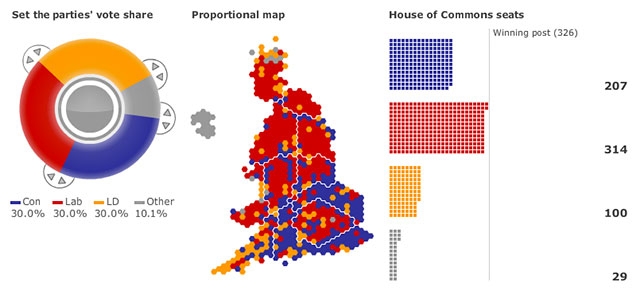 Many U.S. voters were outraged in the 2000 presidential election when Bush Jr. won despite losing the popular vote. But Britain's electoral map is even weirder. After a spectacular TV debate performance by the leader of the Liberal Democrats--traditional also-rans in UK general elections--the three main parties are nearly tied in polling. And yet still the Lib Dems would win only half the seats in parliament scored by either of the other two parties; and Labour, behind the other two in the polls, would win by far the most. Many U.S. voters were outraged in the 2000 presidential election when Bush Jr. won despite losing the popular vote. But Britain's electoral map is even weirder. After a spectacular TV debate performance by the leader of the Liberal Democrats--traditional also-rans in UK general elections--the three main parties are nearly tied in polling. And yet still the Lib Dems would win only half the seats in parliament scored by either of the other two parties; and Labour, behind the other two in the polls, would win by far the most. A Sun newspaper poll, carried out after the TV debate, suggests Labour are in third place on 28% (down 3%), with the Lib Dems on 30% (up 8%) and the Conservatives 33% (down 4%). Applying the figures from The Sun poll, which came from a YouGov survey of 1,290 people, to the BBC News website's election seat calculator, results in the following: Labour 276 seats; Conservatives 245 seats; Lib Dems 100 seats; Others 29 seats.The BBC has a neat web app that illustrates the problem. For example, for each of the three parties to win 207 seats in Parliament, the Lib Dems would have to get 37.4% of the vote, the Conservatives 30%, and Labour only 24.5%. |
| Adam Savage's speech to the Harvard humanists Posted: 19 Apr 2010 08:36 AM PDT  Photo: Troy Holden Harvard Secular Society conferred lifetime achievement awards on MythBusters' Adam Savage and Jamie Hyneman this weekend. Adam's splendid acceptance speech follows. Food for The Eagle - Adam Savage's speech to Harvard humanists Photo: Troy Holden Harvard Secular Society conferred lifetime achievement awards on MythBusters' Adam Savage and Jamie Hyneman this weekend. Adam's splendid acceptance speech follows. Food for The Eagle - Adam Savage's speech to Harvard humanists |
| Posted: 19 Apr 2010 08:10 AM PDT Engadget gets shots of the new iPhone. But is it real? Gizmodo confirms the curious new design: it has the actual thing in hand. Glass on both sides? Gruber finds the patent. |
| The Asian Art Museum does Shanghai: opium hulks, Communist propaganda, and neon brush strokes Posted: 12 Apr 2010 11:55 AM PDT  It Often Begins with a Smile, 1930s. By Jin Meisheng (19021989). Chromolithograph on paper. Collection of the Shanghai History Museum. It Often Begins with a Smile, 1930s. By Jin Meisheng (19021989). Chromolithograph on paper. Collection of the Shanghai History Museum. The Asian Art Museum in San Francisco has a great exhibit right now called Shanghai. I was drawn to it because I really enjoy the visual evolution of cities, but also because my mother's side of the family is from Shanghai and many of my ancestral anecdotes originate there. Shanghai has gone through some incredibly eclectic, non-linear changes in the last century and a half, from the early days of Western influence through the Cultural Revolution to post-revolution renewal; this year, it celebrates how far it's come by hosting the World Expo. Dany Chan, the museum's assistant curator for Chinese art, took me on a tour of the galleries last week.
You can catch Shanghai at the Asian Art Museum through September 5th. |
| GoogleSharing: blending your net-activity with others to trick Google Posted: 19 Apr 2010 06:50 AM PDT GoogleSharing is a pretty ingenious new plugin and service for mixing up your search and browsing history with other net users and transmitting it to Google, so that you are harder to track. I couldn't find an independent source-code audit (which would be reassuring) -- anyone want to conduct one? The GoogleSharing system consists of a custom proxy and a Firefox Addon. The proxy works by generating a pool of GoogleSharing "identities," each of which contains a cookie issued by Google and an arbitrary User-Agent for one of several popular browsers. The Firefox Addon watches for requests to Google services from your browser, and when enabled will transparently redirect all of them (except for things like Gmail) to a GoogleSharing proxy. There your request is stripped of all identifying information and replaced with the information from a GoogleSharing identity.GoogleSharing (via MacWorld UK) |
| TOR for Android: anonymize your phone's data-connection Posted: 19 Apr 2010 06:50 AM PDT  TOR (The Onion Router, a technology for bouncing your traffic all over the net so that your ISP can't spy on you) is now available for Android phones. Just take a picture of the QR code on the right with your Barcode Scanner or Goggles app to install it. TOR (The Onion Router, a technology for bouncing your traffic all over the net so that your ISP can't spy on you) is now available for Android phones. Just take a picture of the QR code on the right with your Barcode Scanner or Goggles app to install it. Tor on Android (via O'Reilly Radar) Previously: |
| George Washington owes $100K in library fines Posted: 19 Apr 2010 05:43 AM PDT According to an old ledger book, George Washington (the George Washington) checked two books (one on international law, one a transcript of debates in the British House of Commons) from the New York Society Library in October, 1789 and never returned them. His inflation-adjusted fines are now more than $100,000. John Adams also failed to return one of the books he checked out. President Accused of Theft, Failing to Pay Massive Library Fines Previously:
|
| You are subscribed to email updates from Boing Boing To stop receiving these emails, you may unsubscribe now. | Email delivery powered by Google |
| Google Inc., 20 West Kinzie, Chicago IL USA 60610 | |

 Last summer, we reached the six-month mark in our cannabis experiment. We'd been using medical marijuana to help quell our autistic son's gut pain and anxiety, and we were seeing some huge changes in his behavior and, presumably, his happiness. J was smiling, interacting (one of home-based therapists said she'd never encountered such an affectionate autistic child), even putting his dirty dishes in the dishwasher—rinsing and everything!—not only without being told, but without ever having been asked to do such a thing. The more I'd been reading, along with J's doctor, about the effects of cannabis—analgesic, anti-anxiety, safe—the more it seemed a logical choice. I've also heard from other parents who've decided to try cannabis for their children. One of the kids has Smith-Magenis, a genetic disorder that includes autismlike behavioral symptoms including self-injury. Another is an autistic child who'd refused to eat and was near death. Post-marijuana, he is thriving. The Smith-Magenis boy, who'd been about to start court-ordered medication, is also doing well.
Last summer, we reached the six-month mark in our cannabis experiment. We'd been using medical marijuana to help quell our autistic son's gut pain and anxiety, and we were seeing some huge changes in his behavior and, presumably, his happiness. J was smiling, interacting (one of home-based therapists said she'd never encountered such an affectionate autistic child), even putting his dirty dishes in the dishwasher—rinsing and everything!—not only without being told, but without ever having been asked to do such a thing. The more I'd been reading, along with J's doctor, about the effects of cannabis—analgesic, anti-anxiety, safe—the more it seemed a logical choice. I've also heard from other parents who've decided to try cannabis for their children. One of the kids has Smith-Magenis, a genetic disorder that includes autismlike behavioral symptoms including self-injury. Another is an autistic child who'd refused to eat and was near death. Post-marijuana, he is thriving. The Smith-Magenis boy, who'd been about to start court-ordered medication, is also doing well.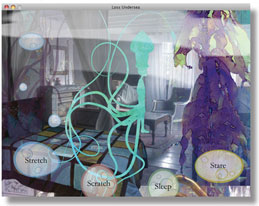
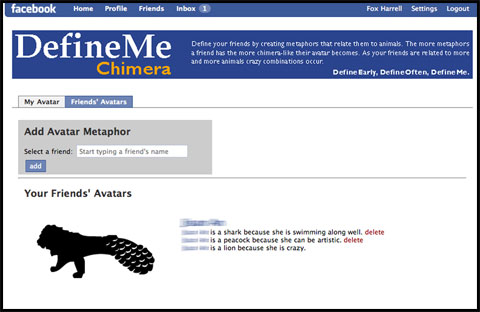
 In and around North Carolina's Green Swamp, poachers uproot them from protected areas as well as private lands, where they can be harvested only with an owner's permission. The plants have such shallow roots that some poachers dig them up with butcher knives or spoons, often while wearing camouflage and kneepads (the plants grow in such convenient clumps that flytrappers, as they're called, barely have to move). Each pilfered plant sells for about 25 cents. The thieves usually live nearby, though occasionally there's an international connection: customs agents at Baltimore-Washington International Airport once intercepted a suitcase containing 9,000 poached flytraps bound for the Netherlands, where they presumably would have been propagated or sold. The smuggler, a Dutchman, carried paperwork claiming the plants were Christmas ferns...
In and around North Carolina's Green Swamp, poachers uproot them from protected areas as well as private lands, where they can be harvested only with an owner's permission. The plants have such shallow roots that some poachers dig them up with butcher knives or spoons, often while wearing camouflage and kneepads (the plants grow in such convenient clumps that flytrappers, as they're called, barely have to move). Each pilfered plant sells for about 25 cents. The thieves usually live nearby, though occasionally there's an international connection: customs agents at Baltimore-Washington International Airport once intercepted a suitcase containing 9,000 poached flytraps bound for the Netherlands, where they presumably would have been propagated or sold. The smuggler, a Dutchman, carried paperwork claiming the plants were Christmas ferns... "By the end of last year, Amazon accounted for an estimated eighty per cent of all electronic book sales, and $9.99 seemed established as the price of an e-book. Publishers were panicked," Auletta writes.
"By the end of last year, Amazon accounted for an estimated eighty per cent of all electronic book sales, and $9.99 seemed established as the price of an e-book. Publishers were panicked," Auletta writes.  View of the Shanghai Bund, approx. 1862-1865
View of the Shanghai Bund, approx. 1862-1865 Wandering Eyes Giving Way to Wandering Thoughts, 1890s. By Wu Youru (18391893). Ink on paper. Collection of the Shanghai History Museum.
Wandering Eyes Giving Way to Wandering Thoughts, 1890s. By Wu Youru (18391893). Ink on paper. Collection of the Shanghai History Museum. A Prosperous City That Never Sleeps, 1930s. By Yuan Xiutang (dates unknown).
A Prosperous City That Never Sleeps, 1930s. By Yuan Xiutang (dates unknown). Mao Zedong, 1968. By Yu Yunjie (Chinese, 19171992).
Mao Zedong, 1968. By Yu Yunjie (Chinese, 19171992). Shanghai Number One Department Store, 1955. By Chen Fei (Chinese, dates unknown),
Shanghai Number One Department Store, 1955. By Chen Fei (Chinese, dates unknown), LandscapeCommemorating
LandscapeCommemorating
No comments:
Post a Comment